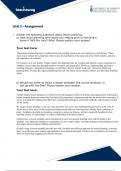Unit 3 - Assignment
1. Answer the following questions about lesson planning:
a) How much planning time would you require prior to teaching a
lesson? (Will this vary? Why? Please explain your answer)
Your text here:
The amount of planning time I would need before teaching a lesson can vary based on several factors. These
factors may include the complexity of the lesson, the familiarity of the topic, the level of the students, and also
my experience as a teacher.
For instance, as a new teacher I might require less planning time for a simple and familiar lesson compared to a
complex or new topic that demands extensive research and preparation. Moreover, implementing innovative
teaching strategies, integrating technology, or catering to diverse learner needs may necessitate additional
planning time. Overall, the required planning time can vary based on the specific context and individual teaching
styles.
b) Would you prefer to follow a lesson template, the course textbook, or
just go with the flow? Please explain your answer.
Your text here:
I prefer using a lesson template as it offers several advantages in terms of structure and organization. Following a
lesson template helps me ensure that I include all the important components and that the lesson flows smoothly. It
serves as a guide for outlining the objectives, instructional strategies, assessment methods, and resources needed
for the lesson.
By using a lesson template, I can save time and effort as I have a pre-established framework to work with. It
allows me to focus more on the content and instructional delivery, knowing that I already have a structure in
place. Templates also help me maintain consistency across my lessons, which is especially beneficial when
teaching a series of related topics or when collaborating with other teachers.
Furthermore, a lesson template can be customized to meet my specific teaching style and the needs of my
students. I can adapt the template to incorporate my own creative ideas, teaching strategies, and learning activities
that align with my students' abilities and interests.
Overall, using a lesson template provides me with a reliable and efficient approach to lesson planning. It ensures
that I cover the necessary content and maintain a clear instructional path. It allows me to maximize my time and
focus on delivering engaging and effective lessons.
, c) Once you’ve taught the lesson, what would you do with your lesson plan? Why?
Your text here:
Once I have taught the lesson, I would keep and review my lesson plan for several reasons. Firstly, it serves as a
valuable reference for future use. If I need to revisit the topic or teach a similar lesson in the future, having the
lesson plan readily available can save time and effort. It allows me to reflect on what worked well and what could
be improved, ensuring continuous professional growth.
Secondly, the lesson plan serves as evidence of my instructional planning and implementation. It can be
beneficial for documentation purposes, such as sharing it with colleagues, or educators to facilitate discussions,
feedback, and the exchange of ideas. It can contribute to a supportive learning community where colleagues can
learn from one another and enhance their teaching practices, or during evaluations to provide a clear record of the
intended learning outcomes, teaching strategies employed, and the assessment methods used.
Additionally, keeping the lesson plan allows for ongoing reflection and self-assessment. By comparing the
planned objectives and activities with the actual outcomes and student engagement during the lesson, I can
evaluate the effectiveness of my instructional strategies and make necessary adjustments for future lessons.
In summary, retaining the lesson plan after teaching the lesson is important for future reference, documentation,
self-assessment, and collaboration. It helps ensure a continuous improvement in instructional planning and
delivery, fostering professional development and facilitating effective teaching practices.
2. Find out the cultural norms or issues relevant to a country you’d like
to teach in. If you’re unsure, choose a hypothetical country or analyze
a language teaching context/audience in your own country (for
example, Chinese students make up the majority of learners in the
post-secondary context in Canada).
Some examples you might want to consider could pertain to:
body language
facial expressions
use of gestures
use of eye contact
concept of personal space
grouping
speaking in class, asking questions
parental involvement
Your text here:
The cultural norms or issues relevant to teaching in Japan. Japan is known for its unique cultural norms and
practices that can impact the teaching and learning environment. Here are some examples:




